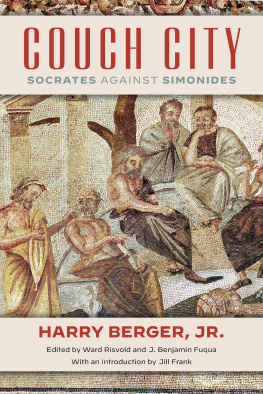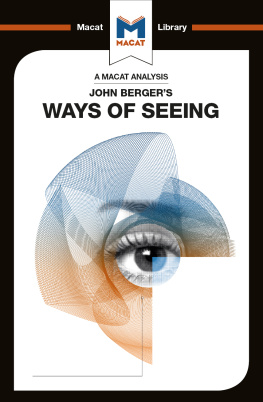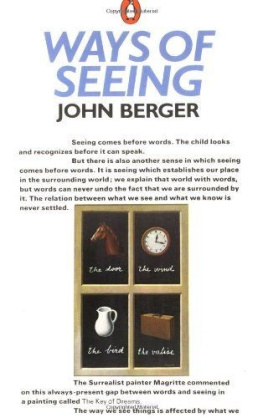THE PERILS OF UGLYTOWN
THE PERILS OF UGLYTOWN
Studies in Structural Misanthropology from Plato to Rembrandt

Harry Berger, Jr.

Copyright 2015 Fordham University Press
All rights reserved. No part of this publication may be reproduced, stored in a retrieval system, or transmitted in any form or by any meanselectronic, mechanical, photocopy, recording, or any otherexcept for brief quotations in printed reviews, without the prior permission of the publisher.
Fordham University Press has no responsibility for the persistence or accuracy of URLs for external or third-party Internet websites referred to in this publication and does not guarantee that any content on such websites is, or will remain, accurate or appropriate.
Fordham University Press also publishes its books in a variety of electronic formats. Some content that appears in print may not be available in electronic books.
Visit us online at www.fordhampress.com.
Library of Congress Cataloging-in-Publication Data
Berger, Harry, Jr., 1924
The perils of uglytown : studies in structural misanthropology from Plato to Rembrandt / Harry Berger, Jr. First edition.
pages cm
Includes bibliographical references.
ISBN 978-0-8232-4516-1 (hardback) ISBN 978-0-8232-4517-8 (paper)
1. Structural anthropology. 2. Philosophical anthropology. 3. PlatoCriticism and interpretation. 4. Alienation (Philosophy) 5. Art, RenaissancePhilosophy. I. Title.
GN362.B44 2015
301dc23
2015002943
Printed in the United States of America
17 16 15 5 4 3 2 1
First edition
to Judith Anderson
and Jill Frank
Contents
Preface
The Perils of Uglytown develops a cultural concept that gets explored first in a series of chapters on Platos dialogues and then in studies of early modern authors and artists ranging from L. B. Alberti to Shakespeare and Rembrandt. The concept, which I call structural misanthropology, is a variation on Claude Lvi-Strausss notion of structural anthropology. In , Misanthropology in Platos Dialogues, I argue that the society Thucydides and Plato represent is an apprehensive society: a society founded on the misanthropic perception of the social order as a system of relationships motivated primarily by apprehensionthat is, by the prehensive desire to take and the apprehensive fear of being taken. I use this term advisedly because prehension is the act of grasping, seizing by the hand, and I connect it to the handwork involved in the culture of inscription based on handwriting (cheiro-graph).
centers on the ways in which Plato develops the concept in his depictions of the dialogue between Socrates and his interlocutors. It shows in detail how Socrates both articulates and deconstructs their wish that the Athenian city-state (the polis) they imagine could be an ideal city, a Kallipolis. The particular dialogues explored in this section are Lysis, Crito, Phaedo, The Republic, and Timaeus. At the heart of Platos account of structural misanthropology is a critique of pleonexia, which means not only having more (a literal translation) but wanting to have more, wanting to be bigger, better, superior. If you suffer from pleonexia, you never have enough because you aspire to total and immortal self-sufficiency even if that involves draining the rest of the world of power, wealth, pleasure, and being.
Rule: take from another before another takes from you. The ethics of pleonexia is well expressed by Polemarchus in the Republic when he defines justice as helping your friends and hurting your enemies.
, Misanthropology in Early Modern Culture, turns to the Renaissance in Italy, the Netherlands, and England. I discuss structural misanthropology first in the work of several Italian humanists (Alberti, Leonardo, Castiglione, and Vasari), then in English drama (Gorbuduc and several plays by Shakespeare), and finally in group portraits by Hals and Rembrandt.
I dedicate this book to Judith Anderson and Jill Frank. For more than half a century Professor Anderson and I have exchanged ideas about anything and everything weve both worked on. The deep insights into literature and interpretation that shine forth from her many books were first shared with me during the middle decades of the last century. My Plato chapters are largely the result of years of conversation with Professor Frank. Her brilliant responses to questions that arose during writing helped me formulate my arguments more clearly and showered bright insights on dark passages I hadnt understood.
Since Im not a classicist, Ive relied heavily on the knowledge, perceptiveness, and good will of several colleagues and friends in addition to Judith and Jill. The wonderful group of classicists at UC Santa Cruz has been with me all the way, and it gives me the greatest pleasure to thank Karen Bassi, Mary-Kay Gamel, Charles Hedrick, John Lynch, Jenny Lynn, Gary Miles, and Dan Selden. Thanks also to other friends and colleagues in literature who have supported, informed, and encouraged my writing projects over the years: Peter Erickson, Jay Farness, Helene Moglen, Forrest Robinson, Deanna Shemek, Ty Miller, Tom Vogler, and Michael Warren. And once again, as always, thanks and love to Beth.
1. A Polar Model of Culture Change
Introduction to Structural Misanthropology
Two Paradoxes: The Paradox of Transcendence, or the Traditional Paradox
The creature becomes the creator of the creation in which it is a creature. This magical or miraculous transformation can occur only if the creature disavows, or remains ignorant of, its act and power of creation and continues to think of itself as the creature, not the creator, of the creation.
For example, we human beings create our gods, our cosmos, our laws of nature, our structures of kinship and gender, and our conceptions of soul or self. Yet if we dont know or believe we made these things up, we confer reality and transcendence on them. Whenever we discover or decide that we made them up, we reduce the gods, the cosmos, and the rest to mere human creations. We demote them to fictions and illusions.
The Paradox of Technology, or the Modern Paradox
The creator becomes the creature of its creation. This unhappy state of affairs occurs even asor becausewe continue to think of ourselves as creators, not creatures, as masters not servants, of our creation.
For example, human beings create technology, machines, economic systems, and political systems. These creations come to shape the environment, the future, the culture, and the behavior of their human creators. They exist over against their creators. They have and develop their own logics of change. They confine, restrict, and occasionally enslave their creators. They defy our attempts to control them and challenge our efforts to keep them instrumental to human ends. They behave as if in fact we did not create them, and so they become realities and transcend human control even though we are aware that we did create them.
From the modern standpoint, the relation between the paradoxes of transcendence and technology can be mapped onto the relation between the cultural conditions that have been called enchantment and disenchantment. I suppose we would then have to introduce a post-modern standpoint that would enable us to appreciate the ways in which the modern paradox generates its own kinds of enchantment.
Next page











